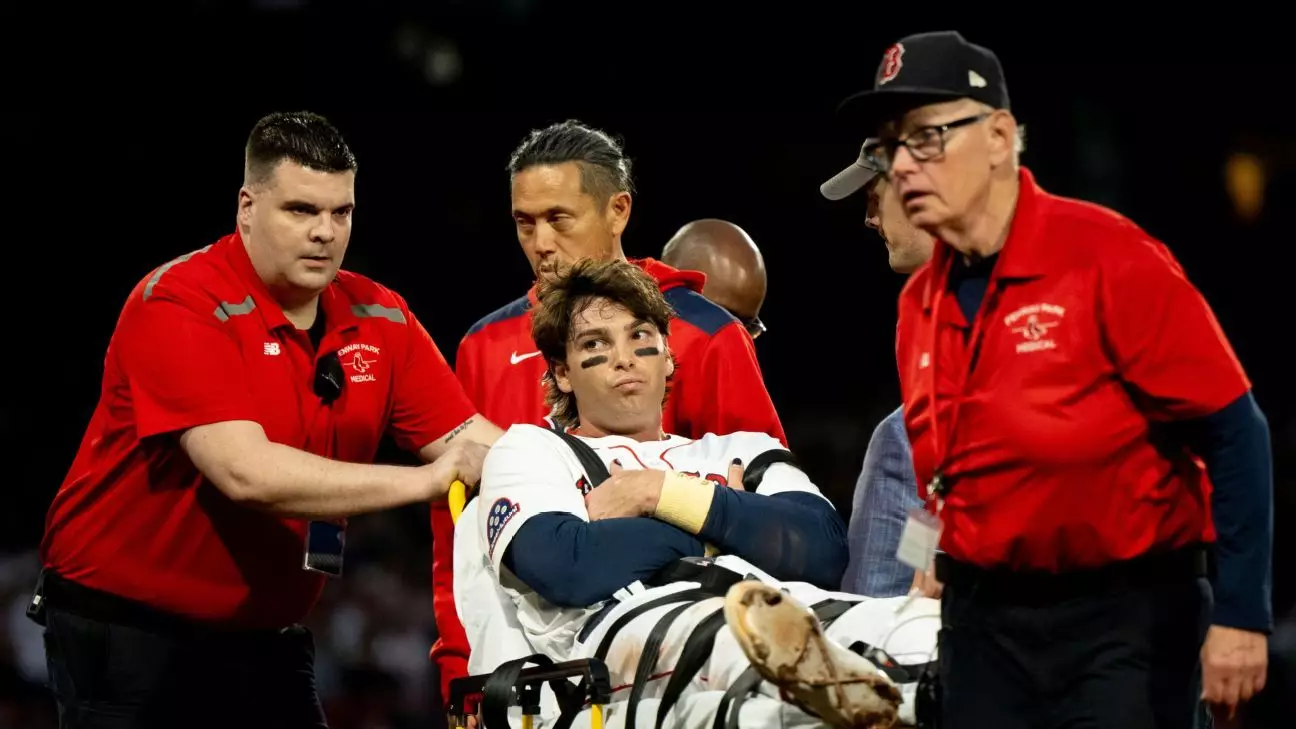The Boston Red Sox are no strangers to setbacks, but the recent injury to first baseman Triston Casas feels particularly devastating. At just 25 years old, Casas was seen as a budding star with significant potential. His unfortunate misstep while running to first base has not only ended his season prematurely, but it also raises serious questions about the team’s trajectory and depth as they push forward in the competitive arena of Major League Baseball.
The incident occurred during a seemingly routine play—a slow roller that unexpectedly turned into a nightmare for both Casas and the Red Sox supporters. After suffering a ruptured patellar tendon, he was carted off the field and subsequently underwent surgery. The severity of this injury is a stark reminder of how fragile the journey of an athlete can be; in an instant, promising careers can be altered, dreams dashed, and futures put on hold.
Beyond the Stats: The Emotional Impact
Stats and metrics often dominate discussions surrounding athletes, yet the emotional weight of an injury can overshadow numerical performance. While Casas struggled with a .182 batting average and only 11 RBIs this season, his contributions went beyond raw statistics. His presence on the field was seen as more than just the numbers he put up; it was about the energy, leadership, and camaraderie he brought to the clubhouse.
Manager Alex Cora recognized the hard work Casas dedicated to his preparation this offseason, indicating just how much the player wanted to reclaim a prominent role after lingering injuries from the previous season. Such backdrop highlights the human side of sports—the athletes are not just machines cranking out numbers; they are passionate individuals enduring mental and physical hardships.
What Lies Ahead for the Red Sox?
With Casas sidelined, the Red Sox face a tough road ahead. General Manager Craig Breslow acknowledged the void his absence creates, particularly concerning the depth at first base. His loss serves as a stark reminder that injuries can derail a team’s momentum, especially when they are relying on young, emerging talent to step up. This setback brings forth a pivotal question: How will the Red Sox adapt to these circumstances and forge ahead?
Cora mentioned that infielder/outfielder Abraham Toro would be selected from Triple-A Worcester to fill the gap, but one cannot help but wonder if the franchise should be considering long-term solutions. The phrase “unfortunately, an opportunity” is often used when teams face significant challenges, but it shouldn’t be viewed as a mere cliché. Instead, it sparks strategic debates about scouting and recruitment—should the Red Sox seek outside talent, or can they cultivate their existing roster to find a suitable long-term replacement for Casas?
Rebuilding Trust and Team Dynamics
An often-overlooked component in the wake of such injuries is the impact on team dynamics and morale. The clubhouse atmosphere can significantly shift, particularly when a popular player like Casas is out of commission. His personality and stature within the group will be sorely missed. Leadership isn’t just about performance on the field; it’s also about mutual support and motivation to pull through adversity collectively.
Rafael Devers, another key figure on the team, has reportedly embraced his new role and is adapting well. This transition period will challenge not only the players’ abilities but also their capacity to maintain unity. The way in which they rally together in the aftermath of this setback will be crucial for the franchise’s mental stamina.
Berking on BelleRow vs. Regret
Dr. Eric Berkson’s surgical expertise may have paved the way for Casas’ recovery, but how the Red Sox handle this situation will also define the team’s future. Fans and analysts alike will be watching closely to see if the club can build on what they have or if they will let this setback spiral into broader issues.
What remains clear is that the Boston Red Sox must adopt a dual approach, focusing on immediate adjustments while keeping an eye on the long-term landscape of the organization. The beauty and complexity of sports lie in their unpredictable nature; it’s a canvas for resilience and tactical engagement. How the Red Sox navigate this challenge could very well set the tone for their future, cementing their standing in the league for years to come, or allowing them to drift into obscurity—defined not by their struggles, but by how they ultimately rise from them.

